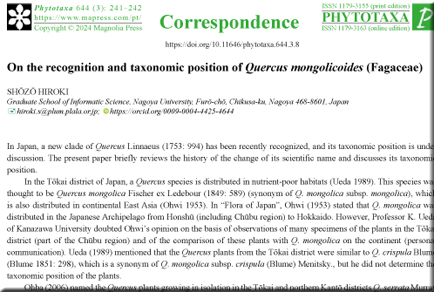Abstract
In Japan, a new clade of Quercus Linnaeus (1753: 994) has been recently recognized, and its taxonomic position is under discussion. The present paper briefly reviews the history of the change of its scientific name and discusses its taxonomic position.
References
- Aizawa, M., Maekawa, K., Mochizuki, H. & Iizuka, K. (2021) Taxonomic revision of Quercus serrata subsp. mongolicoides. Acta Phytotaxonomica et Geobotanica 72: 113–123.
- Albarrán-Lara, A.L., Petit, R.J., Kremer, A., Caron, H., Penaloza-Ramírez, J.M., Gugger, P.F., Dávila-Aranda, P.D. & Oyama, K. (2019) Low genetic differentiation between two morphologically and ecologically distinct giant-leaved Mexican oaks. Journal of Systematics and Evolution 305: 89–101. https://doi.org/10.1007/s00606-018-1554-8
- Blume, C.L. (1851) Museum Botanicum 1. Lugduni-Batavorum, 396 pp. with 24 plates. https://doi.org/10.1163/9789004587410
- Hiroki, S. (2013a) Unique root elongation habit of Quercus serrata subsp. mongolicoides in Japan’s Tōkai District. Journal of Phytogeography and Taxonomy 61: 15–19.
- Hiroki, S. (2013b) Differences in survival of Quercus serrata subsp. mongolicoides and Quercus variabilis in a granodiorite area in Aichi Prefecture, Japan. Journal of General Education (Laboratory of General Education of Aichi University) 45: 13–16.
- Hiroki, S. (2017) A new scientific name proposed for a unique deciduous Quercus in Chūbu and Kantō districts, Japan. Journal of Phytogeography and Taxonomy 64: 73–76.
- Lieblein, F.K. (1784) Flora Fuldensis, Frankfurt am Main, 496 pp. [https://www.ipni.org/]
- Ledebour, C.F. (1849) Flora Rossica 3, Sumtibus Libraiae Emanuel Schweizerbalt, Stuttgartiae, 866 pp. [https://www.biodiversitylibrary.org]
- Liebmann, F.M. (1854) Oversigt over det Kongelige Danske Videnskabernes Selskabs Forthandlinger, Bianco Lunos Bogtrikkenhaven, Kjübenhaven, 430 pp. with 12 tables. [https://www.ipni.org/]
- Linnaeus, Carl von (1753) Species Plantarum. Impensis Laurentii Salvii, Holmiae, 1231 pp. [https://www.biodiversitylibrary.org]
- Murray, J.A. (1784) Systema Vegetabilivm. Christ Dieterich, Gottingae, 1004 pp. [https://www.biodiversitylibrary.org]
- Muir, G. & Schlötterer, C. (2005) Evidence for shared ancestral polymorphism rather than recurrent gene flow at microsatellite loci differentiating two hybridizing oaks (Quercus spp.). Molecular Ecology 14: 549–561. https://doi.org/10.1111/j.1365-294X.2004.02418.x
- Née, L. (1801) Anales de Ciencias Naturales, Datos de Publicación, Madrid, 318 pp. with 2 plates. [https://bibdigital.rjb.csic.es]
- Ohba, H. (2006) Fagaceae. In: Iwatsuki, K., Boufford, D.E. & Ohba, H. (Eds.) Flora of Japan Volume IIa Angiospermae Dicotyledoneae Archichlamydeae(a). Kodansha LTD., Tokyo, pp. 42–60, 550 pp.
- Ohwi, T. (1953) Flora of Japan. Shibundo, Tokyo, 1383 pp.
- Serizawa, S. (2008) On Quercus serrata subsp. mongolicoides (Fagaceae). Shidekobushi 1 (1): 54–55.
- Ueda, K. (1989) Phytogeography of Tokai Hilly-Land Element I. Definition. Acta Phytotaxonomica et Geobotanica 40: 190–202


